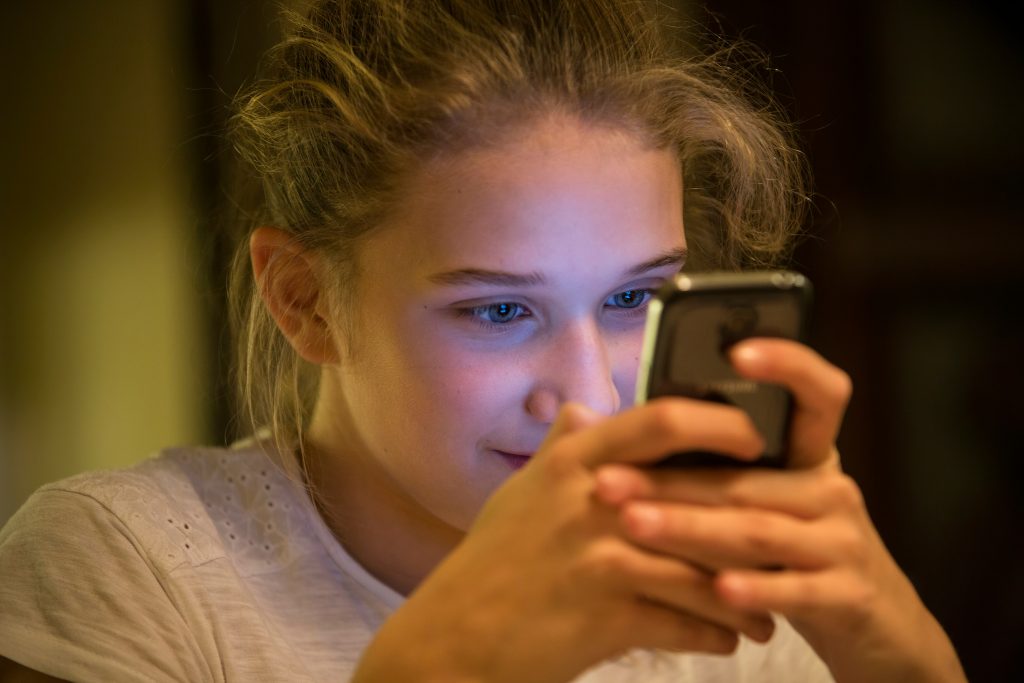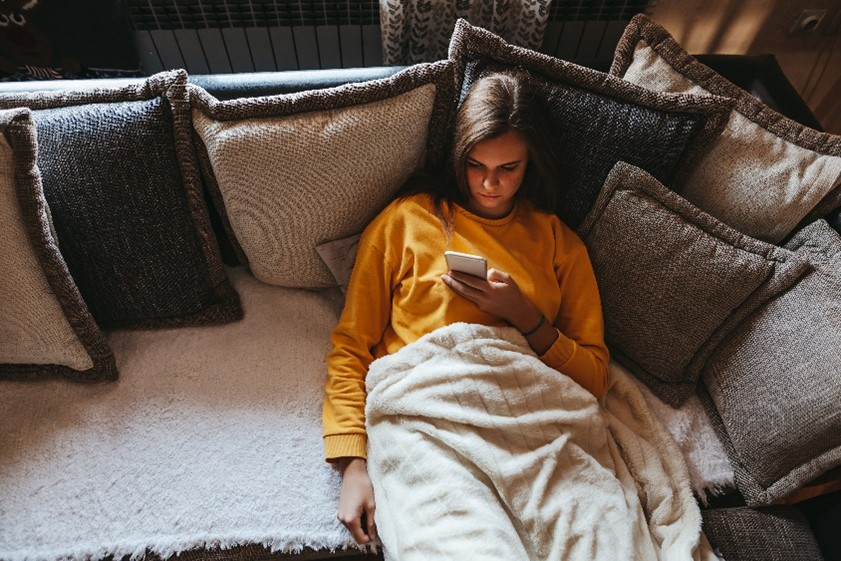 This year’s high school seniors have never lived in a world without smartphones.
This year’s high school seniors have never lived in a world without smartphones.
Johnny Cohen/Unsplash
Kids are spending more time on screens than ever. Experts say their screen time is hurting their mental health.
Smartphones have been around since 2007, meaning this year’s high school seniors have never lived in a world without smartphones.
The American Academy of Child and Adolescent Psychiatry reported in June that children ages 8 to 18 spent 7.5 hours per day watching or using screens.
Rates of anxiety, depression and suicide have been rising in the United States since 2010, particularly among young people.
“The roots of depression and anxiety in humans are very ancient. But there is a lot of evidence, and I think the evidence is increasing, that the massive uptake of cellular phone use starting around 2010 has been a significant contributor to this pattern of increasing anxiety and depression in young people,” said Dr. Charles Raison, psychiatrist and executive director of the Vail Health Behavioral Health Innovation Center.

Support Local JournalismDonate
Raison was speaking on a video recording for a panel hosted by Vail Health and the Eagle County School District at the EagleVail Pavilion on Nov. 12, titled “Teens and Screens: Understanding the Link to Depression.” The rest of the speakers participated in person.
 Adolescents, whose frontal lobes are still developing, lack the impulse control of adults, making it more difficult for kids and teens to put down their devices.AP
Adolescents, whose frontal lobes are still developing, lack the impulse control of adults, making it more difficult for kids and teens to put down their devices.AP
How do screens contribute to worsening mental health?
Eagle County’s Healthy Kids Colorado 2023 survey results showed that 62% of middle schoolers and 68% of high schoolers reported spending 3 or more hours per day on their devices for non-school purposes.
Lucy Tamborino, a senior at Battle Mountain High School, said that when she was struggling with her mental health, the social media she turned to as a source of healing quickly made her feel worse.
“Instead of finding hope, I found comparison; instead of finding connection, I found pressure,” she said.
“That cycle, that never-ending scroll, it started to convince me that everyone else was doing better. Healing faster, smiling more and living a life I could never have,” Tamborino said. “That’s when I realized, technology doesn’t just show us the world. It shapes how we see ourselves in it.”
Cell phone use inhibits face-to-face social interaction and increases sleep deprivation and attention fragmentation. The deliberately addictive nature of many apps, including social media, has interfered with natural dopamine production.
Kids are showing up for school “overstimulated,” “distracted,” and “sensation-seeking,” said Candice Eves, Eagle County School District’s prevention coordinator. “Their attention spans are shot.”
The human brain does not finish developing until age 25. Adolescents, whose frontal lobes are still developing, lack the impulse control of adults, making it more difficult for kids and teens to put down their devices.
“Our brains are wired to seek rewards. When the phone dings, when we get a light, when we see a message, when we get some kind of notification, dopamine is released from the brain,” said Dr. Elaine Sandler, a child, adolescent and adult psychiatrist at Vail Health.
 This file photo shows the Instagram app icon on the screen of a mobile device. When whistleblower Frances Haugen on Tuesday, Oct. 5, 2021, revealed internal Facebook studies of the harms its Instagram service can cause, particularly for teenagers, she reinforced concerns about the popular photo-sharing app. Experts say there are some steps parents can take to help kids navigate the dangers of social media while still allowing them to chat with peers on their own terms. Jenny Kane/AP file
This file photo shows the Instagram app icon on the screen of a mobile device. When whistleblower Frances Haugen on Tuesday, Oct. 5, 2021, revealed internal Facebook studies of the harms its Instagram service can cause, particularly for teenagers, she reinforced concerns about the popular photo-sharing app. Experts say there are some steps parents can take to help kids navigate the dangers of social media while still allowing them to chat with peers on their own terms. Jenny Kane/AP file
Dopamine is the feel-good chemical in the brain. “When dopamine is released, we want more of it,” Sandler said.
When teens spend more time on their technology, they often lose out on really connecting with others.
“Humans are social beings … we need face-to-face connection,” Sandler said.
When people spend time together in person, a hormone called oxytocin is released, which is crucial for social bonding.
“Without that and more screens, teens can feel more alone than ever,” Sandler said.
For adolescents, technology use at night interferes with sleep, which is crucial for information processing, growth, brain development, mental health and more.
In Eagle County, 40% of middle and 58% of high school students reported on the 2023 Healthy Kids Colorado Survey that they got eight or fewer hours of sleep per night.
“A day coming to school with bad sleep is a day where learning is not happening, emotional regulation is not happening, and that’s just lost time,” said Dana Whelan, Eagle County School District’s wellness coordinator.
Constant notifications have led students to check their devices frequently, affecting their attention spans.
High social media use, which often shows young people content that makes them feel like they are not good enough, can impact their self-esteem, particularly for young women.
The Global Mind Project, aggregated data from 2 million kids and teenagers from 163 countries between 2020 and 2025.
“What they found is that … if you get a smartphone under the age of 13, you’re more likely to have a poor outcome in adulthood,” Sandler said.
There was a pronounced difference in how technology use impacted girls and boys. “In girls, it looked like they had lower self-worth, lower self-esteem, more anxiety, lower emotional resilience,” Sandler said. “In boys, it was more anger, less ability to be calm and less empathy.”
Social media and phones also give students an “unmonitored” space to converse,” Eves said. This can lead to bullying, body image issues and exposure to negative influences, including advertisers.
“They know your kids. They know how to target your kids. And it’s working,” Eves said.
Eves said most of the middle and high school students she works with have seen e-cigarette advertisements on their social media, as companies can reach teens without their parents’ knowledge.
“I would encourage you all to sit down and go through a social media scroll with your students,” Whelan said. “Look at the images that they’re seeing and have conversations.”
But stepping away from technology poses other social challenges for adolescents.
“We are growing up in a world where our worth feels measured by likes, where silence feels like invisibility and where lack of social media presence equates to irrelevance,” Tamborino said.
How to help kids limit their screen time
Families can help their kids spend less time on their phones. If a family limits phone time, they can see improvement in feelings of depression and anxiety, Raison said.
Eagle County School District has a cell phone policy. Middle school students must put their non-school-related technology “away for the day.” High schoolers are required to put their devices away during each class.
“We need parents’ support to bring an away for the day policy to the high schools,” Eves said.
Whelan said she compares teaching kids how to use screens in a healthy way to teaching teens to drive.
“There’s this period of time where we’re sitting there beside them,” Whelan said.
“This is something we can do together as a community that would really have a lasting impact in our young people,” Raison said.
Sandler suggested parents implement structures like charging phones outside the bedroom at night and putting the whole family’s phones in a basket during dinner. Parents also need to model phone-free behavior, as “kids notice” adults spending time on screens, she said.
Teagan Butters, a freshman at Eagle Valley High School, also suggested parents utilize parental controls, which enable parents to limit the amount of time their kids can spend on their devices and which apps and websites they can visit.
“Parental controls help set borders when you can’t,” Butters said.
“The goal is not to eliminate phones, it’s to reclaim time,” Sandler said. “The goal is better connection with ourselves, with our families and with the world around us.”
